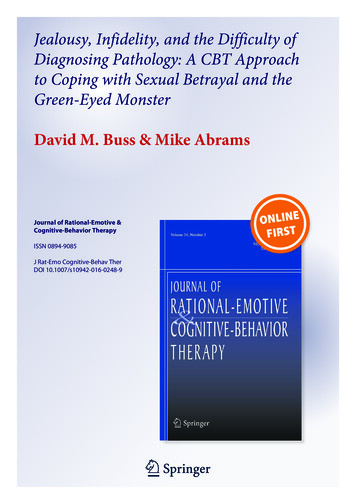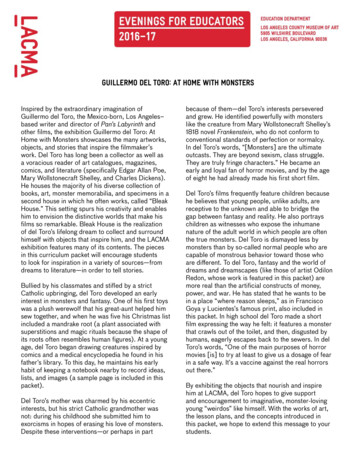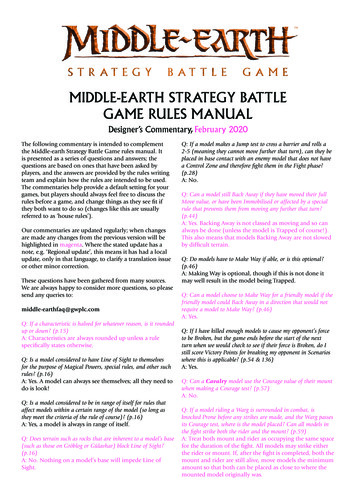
Transcription
Jealousy, Infidelity, and the Difficulty ofDiagnosing Pathology: A CBT Approachto Coping with Sexual Betrayal and theGreen-Eyed MonsterDavid M. Buss & Mike AbramsJournal of Rational-Emotive &Cognitive-Behavior TherapyISSN 0894-9085J Rat-Emo Cognitive-Behav TherDOI 10.1007/s10942-016-0248-91 23
Your article is protected by copyright and allrights are held exclusively by Springer Science Business Media New York. This e-offprint isfor personal use only and shall not be selfarchived in electronic repositories. If you wishto self-archive your article, please use theaccepted manuscript version for posting onyour own website. You may further depositthe accepted manuscript version in anyrepository, provided it is only made publiclyavailable 12 months after official publicationor later and provided acknowledgement isgiven to the original source of publicationand a link is inserted to the published articleon Springer's website. The link must beaccompanied by the following text: "The finalpublication is available at link.springer.com”.1 23
Author's personal copyJ Rat-Emo Cognitive-Behav TherDOI 10.1007/s10942-016-0248-9Jealousy, Infidelity, and the Difficulty of DiagnosingPathology: A CBT Approach to Coping with SexualBetrayal and the Green-Eyed MonsterDavid M. Buss1 Mike Abrams2! Springer Science Business Media New York 2016Abstract Humans have evolved adaptations for infidelity, as well defenses againsta partner’s betrayal—centrally the emotion of jealousy. Both create problems thatbring couples to therapy. Diagnosing jealousy as pathological versus normal turnsout to be difficult, in part because infidelity has evolved to be concealed from thebetrayed mate, which creates a signal detection problem. Because missing an infidelity committed by a mate has been more costly in evolutionary currencies thanfalsely suspecting a partner of cheating, selection has created an error managementcognitive bias to over-infer a partner’s betrayal. Moreover, adaptations for jealousybecome activated by predictors of infidelity, such as mate value discrepancies, whenno actual infidelities have occurred. Cognitive-behavior therapy (CBT) offers several ways to deal with these complexities. One way is to highlight potential mismatches, distinguishing between jealous emotions that were functional in ancestralenvironments but are less so in modern environments. A second is to distinguishbetween the goal of personal well-being and reproductive outcomes. Understandingthe evolutionary logic of jealousy, in short, provides patients with conceptual toolsfor cognitively reframing jealousy and infidelity.Keywords Jealousy ! Infidelity ! Error management ! CBT& David M. Bussdbuss@austin.utexas.edu& Mike Abramsmike.abrams@nyu.edu1Department of Psychology, University of Texas, Austin, TX 78712, USA2New York University, New York, NY, USA123
Author's personal copyD. M. Buss, M. AbramsIntroductionIntense jealousy can be emotional acid that corrodes marriages, undermines selfesteem, triggers battering, and is a key motive in the murder of mates and ex-mates(Buss 2000a, b; Buss and Duntley 2011; Daly and Wilson 1988; Daly et al. 1982).Extreme jealousy has been given many names in the clinical and psychiatricliterature—The Othello Syndrome, Morbid Jealousy, Psychotic Jealousy, Pathological Jealousy, Conjugal Paranoia, and Erotic Jealousy Syndrome. Jealousy, ofcourse, can be pathological. It can destroy previously harmonious relationships,rendering them hellish nightmares of daily existence. Trust slowly built from yearsof mutual reliance can be torn asunder. Jealousy by romantic partners causes morewomen to flee in terror to shelters for battered women than any other cause (Wilsonand Daly 1996).A full 13 % of all homicides are spousal murders, and jealousy is overwhelmingly the leading cause (Buss 2005; Daly and Wilson 1988). When an adult womanis murdered, the odds are between 50 and 70 % that the perpetrator is a husband,boyfriend, ex-husband, or ex-boyfriend. A common sentiment expressed by thesekillers is ‘‘If I can’t have her, no one can.’’ Jealousy is a dangerous emotion that hasdriven lovers to such violent extremes that many cultures have laws specificallytailored to it—crimes of passion.One pathological aspect of extreme jealousy, according to traditional psychiatricthinking, is not the jealousy itself. It is the delusion that a loved one has committedan infidelity when none has occurred. The rage itself upon the actual discovery of aninfidelity is something people everywhere intuitively understand. In Texas until1974, a husband who killed a wife and her lover when he caught them in flagrantedelicto was not judged a murderer. In fact, the law held that a ‘‘reasonable man’’would respond to such extreme provocation with acts of violence. Similar laws havebeen on the books worldwide. In France, Italy, the UK, Brazil, and Uruguay, forexample, killing in this context typically resulted in reduced criminal charges, suchas from murder to manslaughter, and reduced sentences if convicted. Extreme rageupon discovering a wife naked in the arms of another man is something that peopleeverywhere find intuitively comprehensible. Criminal acts that would normallyreceive harsh prison sentences routinely get reduced when the victim’s infidelity ora mate poacher’s conduct are the extenuating circumstance. Why do people intuitthat a ‘‘reasonable man’’ would be driven to such extremes? And are diagnoses ofpathological jealousy destruction always warranted?A professional couples’ therapist related the following story. A young couple wewill call Joan and Richard came to her with a presenting complaint of irrationaljealousy. Without provocation, Richard would burst into jealous tirades and accuseJoan of sleeping with another man. His uncontrollable jealousy was destroying theirmarriage. Richard and Joan both agreed on this point. Could the therapist help cureRichard of irrational jealousy?A common practice in therapy for couples is to have at least one session witheach member of the couple individually. The first question the therapist posed toJoan during this individual interview was: Are you having an affair? She burst into123
Author's personal copyJealousy, Infidelity, and the Difficulty of Diagnosing tears and confessed that, indeed, she had been carrying on an affair for the past6 months. Having confessed to the therapist, Joan felt obligated to reveal thisinformation to her husband. They ended up divorcing. Richard’s jealousy, it turnedout, had not been irrational after all. Presumably, he had been picking up on subtlecues that triggered his jealousy. Since he trusted Joan and she had assured him ofher fidelity, however, he became convinced, with Joan’s help, that his jealousy hadbeen irrational. In a sense, Richard had failed to listen to his internal emotionalwisdom.In scientific surveys of jealousy, nearly all men and women report havingexperienced at least one episode of intense jealousy (Buss 2000a, b). Thirty-onepercent say that their personal jealousy has sometimes been difficult to control. Andamong those who admit to being jealous, 38 % say that their jealousy has led themto want to hurt someone. This intense emotion, in short, is not limited to spousekillers.The Evolution of JealousyDespite its dangerous manifestations, jealousy helped to solve critical reproductivequandaries for ancestral men and women. Consider first a fundamental sexdifference in our reproductive biology—the fact that fertilization takes place insidewomen’s bodies and not men’s. Internal female fertilization is not universal in thebiological world. In some species, such as the Mormon crickets, fertilization occursinternally within the male. The female takes her egg and literally implants it withinthe male, who then incubates it until birth. In other species, fertilization occursexternally to both sexes. The female salmon, for example, drops her collection ofeggs after swimming upstream, the male follows and deposits his sperm on top, andthen they die, having fulfilled the only mission in life that evolution gave them. Buthumans are not like salmon. Nor are we like Mormon crickets. In all 5416 species ofmammals, of which we are one, and in all 350 species of primates, of which we arealso one, fertilization occurs internally within the female, not the male. This posed aserious problem for ancestral men—the problem of uncertainty in paternity.From an ancestral man’s perspective, the single most damaging form of infidelityhis partner could commit, in the currency of reproduction, would have been a sexualinfidelity. A woman’s sexual infidelity jeopardizes a man’s confidence that he is thegenetic father of her children. A cuckolded man risks investing years or evendecades in another man’s children. Lost would be all the effort he expended inselecting and attracting his partner. Moreover, he would lose his partner’s labors,now channeled to a rival’s children rather than his own.Women, on the other hand, have always been 100 % sure that they are themothers of their children—internal fertilization guarantees that their children aregenetically their own. No woman ever gave birth and, watching the child emergefrom her womb, wondered whether the child was really hers. One African culturecaptures this sex difference with a phrase more telling than any technical summary:‘‘Mama’s baby, papa’s maybe.’’ Biology has granted women a confidence in geneticparenthood that no man can share with absolute certainty.123
Author's personal copyD. M. Buss, M. AbramsOur ancestral mothers confronted a different problem—the loss of a partner’scommitment to a rival woman and her children. Because emotional involvement isthe most reliable signal of this disastrous loss, women key in on cues to a partner’sfeelings for other women. A husband’s one-night sexual stand is agonizing, ofcourse, but most women want to know: ‘‘Do you love her?’’ Most women find asingular lapse in fidelity without emotional involvement easier to forgive than thenightmare of another woman capturing her partner’s tenderness, time, and attention(Shackelford et al. 2002). We evolved from ancestral mothers whose jealousyerupted at signals of the loss of love—mothers who acted to ensure the man’scommitment.But who cares who fathers a child or where a man’s commitments get channeled?Shouldn’t we love all children equally? Perhaps in some utopian future, we might,but that is not how the human mind is designed. Husbands in our evolutionary pastwho failed to care whether a wife succumbed to sex with other men and wives whoremained stoic when confronted with their husband’s emotional infidelity may beadmirable in a certain light. Perhaps these self-possessed men and women weremore mature. Some theories, in fact, propose that jealousy is an immature emotion,a sign of insecurity, neurosis, or flawed character. Non-jealous men and women,however, are not our ancestors, having been left in the evolutionary dust by rivalswith different passionate sensibilities. We all come from a long lineage of ancestorswho possessed the dangerous passion.Jealousy, according to this theory, is an adaptation. An adaptation, in the parlanceof evolutionary psychology, is an evolved solution to a recurrent problem ofsurvival or reproduction. Humans, for example, have evolved food preferences forsugar, fat, and protein that are adaptive solutions to the survival problem of foodselection. We have evolved specialized fears of snakes, spiders, and strangers thatare adaptive solutions to ancestral problems inflicted by dangerous species,including ourselves. We have evolved specialized preferences for certain qualitiesin potential mates, which helped to solve the problems posed by reproduction.Adaptations, in short, exist in modern humans today because they helped ourancestors to combat all of the many ‘‘hostile forces of nature,’’ enabling them tobetter survive and reproduce. Adaptations are coping devices passed down overmillennia because they worked—not perfectly, of course, but they helped ancestralhumans to struggle through the evolutionary bottlenecks of survival andreproduction.Many expressions of jealousy, according to this perspective, are not signs ofimmaturity, but rather important passions that helped out ancestors, and most likelycontinue to help us today, to cope with a host of real relationship and reproductivethreats. Jealousy, for example, motivates us to ward off rivals with verbal threatsand cold primate stares (Shackelford and Buss 1996). It drives us to keep partnersfrom straying with tactics such as escalating vigilance or showering a partner withaffection. And it communicates commitment to a partner who may be wavering,serving an important purpose in the maintenance of love. Sexual jealousy is often asuccessful, although sometimes dangerous, solution to persistent predicaments thateach one of our ancestors was forced to confront.123
Author's personal copyJealousy, Infidelity, and the Difficulty of Diagnosing We are typically not conscious of these reproductive quandaries. Nor are weusually aware of the evolutionary logic that led to this dangerous passion. Men donot think: ‘‘Oh, if my wife has sex with someone else, the certainty that I’m thegenetic father is jeopardized, thereby endangering my genetic legacy I’m reallymad!’’ Nor does a man whose partner uses birth control think, ‘‘Well, because Joanis taking the pill, it doesn’t really matter whether she has sex with other men; afterall paternity is not an issue.’’ Nor does a woman think: ‘‘It’s really upsetting thatDennis is in love with that shrew instead of me; this jeopardizes my hold on hisemotional commitments to me and my children, and hence hurts my overallreproductive success.’’ Instead, jealousy is an essential passion, just as our hungerfor sweets and our craving for companionship are evolved adaptations. Jealousy canbe considered a type of nonconscious emotional wisdom passed down to us overmillions of years by our successful forebears.Jealous men were more likely to reserve the expensive resource of parentalinvestment for their biological children, rather than squandering it on the childrenof rivals. As descendants of a long line of men who acted to ensure their paternity,modern men carry with them the dangerous passion that led to their forebear’sreproductive success.According to this hypothesis, jealousy represents a form of ancestral wisdom thatcan have useful as well as destructive consequences. The view of extreme jealousyas inevitably pathological ignores a profound fact about an important defensedesigned to combat three real threats to intimate relationships—infidelity, potentialmate poachers, and a partner’s outright defection from the relationship. Jealousy isnot always a reaction to an infidelity that has already been discovered. It can be ananticipatory response to adaptive problems such as a mate value discrepancy or tothe sudden presence of potential mate poachers (Schmitt and Buss 2001). So it canbe a preemptive strike to prevent an infidelity or defection that might occur.Labeling jealousy as delusional or pathological simply because a spouse has not yetstrayed ignores the fact that jealousy can head off an infidelity that might be lurkingon the horizon of a relationship.The Difficulty of Diagnosing When Jealousy is a Pathological DisorderSome expressions of jealousy clearly qualify as psychologically disordered. TheDSM notes one form—Delusional Disorder-Jealous Type (Easton et al. 2008). Thisrequires clear evidence of delusions of a partner’s infidelity when no infidelity hasoccurred. Consider this case. On Christmas eve, a man looked out of his living roomwindow across the street, and noticed his neighbor’s Christmas tree lights blinking.When he compared them to the analogous lights his wife had set on their tree, henoticed that they were blinking in synchrony with those of the neighbor. Heconcluded that his wife was having an affair. His wife insisted that he see apsychiatrist, who diagnosed him with delusional jealousy. As it turned out, his wifewas indeed having an affair. Moreover, she was having an affair with that specificneighbor. So is delusional jealousy the proper diagnosis? Clearly, there was adelusional component; it is extremely improbable that there existed Christmas tree123
Author's personal copyD. M. Buss, M. Abramslight synchrony intentionally created by his wife and his neighbor. But his inferenceof his wife’s infidelity was perfectly on target and not delusional.Some have offered criteria for distinguishing normal from pathological jealousy.For example, Marazziti et al. (2003) identify these key criteria: Time taken up by jealous concerns.Difficulty in putting the concerns out of the mind.Impairment of the relationship.Limitation of the partner’s freedom.Checking on the partner’s behavior.The difficulty with the application of these criteria is that they are overly broad. Ifa partner is indeed having an affair, or perhaps even considering having an affair,these expressions of jealousy may signal the normal operation of the adaptation ofjealousy. Limiting the partner’s freedom and even extremes of checking on thepartner’s behavior to the point of stalking are common manifestations of mateguarding (Buss 1988; Buss and Shackelford 1997a, b).Kingham and Gordon (2004) offers these common symptoms of pathologicaljealousy: Accusing partner of looking or giving attention to other people.Questioning of the partner’s behavior.Interrogation of phone calls, including wrong numbers or accidental phone calls,and all other forms of communication.Going through the partner’s belongings.Always asking where the partner is and whom they are with.Isolating partner from their family and friends.Not letting the partner have personal interests or hobbies outside the house.Controlling the partner’s social circle.Claiming the partner is having an affair when they withdraw or try to escape abuse.Accusing the partner of holding affairs when the marriage’s sexual activity stopsbecause of the abuse.Lack of trust.Verbal and/or physical violence toward the partner, the individual whom isconsidered to be the rival, or both.Blaming the partner and establishing an excuse for jealous behavior.Denying the jealous behavior unless cornered.Again, however, all of these behaviors have been documented as common mateguarding and retention tactics whose frequency is increased when someone facesone of the adaptive problems of partner infidelity, threat of mate defection, presenceof mate poachers, or all three (Buss 2000a, b). Even threats of harm to self if apartner threatens to leave the relationship and verbal or physical violence directed apartner are common expressions of mate guarding across cultures (Buss 1988; Buss2000a, b; Buss and Duntley 2011). A threat of suicide if a partner leaves sometimessolves an adaptive problem of mate retention and the partner stays. And often,violence and threats of violence cause a woman to stay in a relationship, even if she123
Author's personal copyJealousy, Infidelity, and the Difficulty of Diagnosing wants to get out, again solving the problem of mate retention. Although physicalviolence toward a spouse is illegal in some cultures, but by no means all, lawsagainst wife-beating and spousal rape are relatively recent and have notcharacterized most of the centuries in which humans have had written laws. Fouradditional problems render a diagnosis of pathology problematic—the signaldetection problem, the on-average effectiveness problem, error management logic,and sensitivity to predictors of infidelity even when none has occurred.The Signal Detection ProblemAlthough infidelity is often morally condemned and seen as a sign of dysfunction, agood case can be made that affairs evolved to solve adaptive problems. For men, thehistorical reproductive benefits of infidelity were fairly straightforward—increasedsexual access to fertile women translated into more offspring and greaterreproductive success (Symons 1979). For women, infidelity is more puzzling, sincerarely could it have translated into higher reproductive output (the exception beingmarried to a man who was impotent or infertile). The two leading evolutionaryhypotheses for female infidelity are (1) securing good genes from an affair partnerwhile securing investment from a regular partner (Gangestad and Haselton 2015),and (2) the mate switching function, by which affairs secure a backup mate, pavethe way for exiting a bad relationship, trading up to a higher mate-value partner, orall three (Buss et al. in press).Because it has been advantageous for some individuals to have an affair, and theaffair comes at a potentially steep cost to the partner, defenses evolved to prevent itsoccurrence. The psychological complex of jealousy and its behavioral output in mateguarding and retention, as discussed above, are the primary co-evolved defenses. Asdefenses against a partner’s infidelity evolved, more sophisticated strategies forconducting affairs evolved. Chief among these were secrecy. As jealousy evolved andbecame more elaborate in design specificity, infidelity got driven underground,cloaked in great secrecy. As one sex became more and more sensitive to subtle cues ofinfidelity, such as unexplained absences, strange scents, changes in sexualinteractions, and many others (Shackelford and Buss 1997), the other became moreadept at concealing these cues. The resulting co-evolutionary arms race created asignal detection problem—how could a calamitous infidelity be detected when cuesto its occurrence were so skillfully concealed? Consequently, motivated monitoring,seemingly paranoid suspicions, cutting off a spouse’s social contacts, isolating apartner, snooping through their belongings—all seen by some as signs of pathology—may instead be the normal behavioral output of an adaptation working effectively todetect intentionally concealed subtle signals. The signal detection problem, in short,poses a problem for distinguishing normal from pathological jealousy.The On-Average Effectiveness of the Jealousy AdaptationAnother problem is that solutions to adaptive problems evolve because, on averageacross the sample space of instances, they solve or ameliorate the problem betterthan alternative designs extant in the population at the time of their evolution. Callus-123
Author's personal copyD. M. Buss, M. Abramsproducing adaptations are designed to protect the anatomical and physiologicalstructures beneath the skin, but those structures sometimes still get damaged despitethe presence of calluses. Adaptations for coalitional warfare can evolve, even if theseresult in the death of the attackers some of the time or even a lot of the time (Tooby andCosmides 2010). In other words, there are many ‘‘instance failures’’ of adaptations,despite their on-average effectiveness (Cosmides and Tooby 1999).Jealousy, an adaptation designed to defend against a partner’s infidelity andpotential defection, also produces many instance failures. Some partners still cheatdespite jealous mate guarding. Some partners still defect, despite the deployment ofthe most effective mate retention tactics at a person’s disposal. These instancefailures do not falsify the hypothesis that jealousy is a well-designed adaptation,since all adaptations work based on their on-average success, not based on theirsuccess in each and every case in which the relevant problem is confronted. Theinevitability of instance failures creates a second problem for distinguishing normalfrom pathological jealousy.Jealousy Embodies Error Management LogicWhen faced with conditions of uncertainty, there are two ways to err—failing to detecta problem that exists and falsely detecting a problem when none exists. A rustling inthe leaves may signal a poisonous snake or a harmless sound stemming from a gust ofwind. The costs of inferential errors differ in this case. Inferring a snake’s existencewhen there is no snake produces relatively trivial caution and avoidance. Failing toinfer a snake’s existence when there is one could result in death. In short, there is oftena cost asymmetry in inferential errors under conditions of uncertainty. According toError Management Theory, recurrent cost asymmetries of this sort result in theevolution of cognitive biases to err in the direction of avoiding the more costly error(Haselton and Buss 2000). A smoke alarm is set sensitively by design to produce manyfalse positives because the cost of missing an actual fire is far steeper than the cost ofdealing with annoying alarm sounds when there is no actual fire.Error management theory logic applies with equal force to the evolved design ofjealousy (Buss 2000a, b). Failing to detect an actual infidelity is generally costlierthan falsely suspecting one that has not occurred. Jealousy-motivated vigilance orsuspicion is generally less costly than being oblivious to an infidelity. Falselysuspecting a spouse of infidelity, of course, can have costs from small to large. Itcould produce relationship conflict, wasting valuable effort on a problem that doesnot exist. Persistent jealousy also sometimes drives a partner out of a relationship orinto the arms of others. But if the on-average cost of erring by falsely suspectinginfidelity exceeds the average cost of missing an infidelity or defection, jealousythresholds will evolve to avoid the more costly error.Jealousy is Triggered by Predictors of Infidelity When No Infidelity HasOccurredThe difficulty of diagnosing when jealousy is pathological becomes furthercompounded by the fact that jealousy is designed to be activated not just by cues to123
Author's personal copyJealousy, Infidelity, and the Difficulty of Diagnosing the actual occurrence of infidelity, but also to statistically recurrent predictors ofinfidelity when no infidelity has actually occurred. Consider mate value. Peoplegenerally couple based on overall mate value; the 8s tend to pair up with other 8s, the 6swith other 6s (Buss 2003; Conroy-Beam & Buss 2016). Over time, however, matevalue discrepancies can emerge. A man or woman might receive a large promotion atwork or large status boost from a career breakthrough, dramatically improving theirmate value. A man or a woman could become ill, suffer a debilitating injury, or suffer astatus loss, dramatically lowering their mate value. Because the components thatcontribute to mate value are never static and always change over time, mate valuediscrepancies inevitably emerge. If they get large enough, they predict infidelity,defection, and mate switching (Buss et al. in press ; Buss and Shackelford 1997b). Ifjealousy is designed to be triggered by a mate value discrepancy, even if no infidelity ordefection has occurred, it can seem pathological when it is not.Mate value discrepancies are not the only statistical predictors. Other candidatesinclude erectile dysfunction, orgasm difficulty, sexual dissatisfaction, decline insexual desire or drive, the sudden introduction of new sexual positions, abruptchanges in clothing style, innocuous but unexplained absences, and many others(Buss 2000a, b; Shackelford and Buss 1997). A man who experiences erectiledysfunction or whose wife becomes sexually dissatisfied may suspect that she willseek sexual gratification elsewhere. Abrupt changes in clothing or sexual positionsmay signal infidelity, but may simply be innocuous attempts to spice up a life ofquiet desperation. Since jealousy is designed to become activated by statisticalpredictors of infidelity, even if it has not occurred and might never occur, it canseem pathological when in fact it is functioning precisely as it was designed tofunction.From an evolutionary perspective, a diagnosis of disorder requires that anevolved mechanism not function as it was designed to function (Wakefield 2005). Inthe case of jealousy, if it gets activated in contexts it was not designed to getactivated, is triggered by drugs or alcohol that produce delusions or abnormally lower thresholds for suspicion for example, it is not functioning as it wasdesigned to function and so can become pathological or disordered. But the signaldetection problem, the on-average success of adaptations that produce manyinstance failures, the adaptive error management biases designed to avoid the morecostly errors even at the expense of more frequent but less costly errors, and the factthat jealousy is activated by statistical predictors of events that have not occurred,render a diagnosis of jealousy as pathological diabolically difficult.Cognitive behavior therapy, however, can produce insights into these difficultiesand help patients with presenting problems of jealousy.Rational-Emotive/Cognitive Behavior Therapy (RE/CBT) Appliedto Jealousy or InfidelityAlthough an evolutionary perspective compellingly depicts jealousy as an adaptation, it is one that can be perceived as maladaptive in many modern social settings.Until very recently, there were fewer normative values against violence, murder or123
Author's personal copyD. M. Buss, M. Abramsany other socially disagreeable manifestations of jealousy (Pinker 2011). Prior towritten laws, judges, juries, and jails, a jealous male could violently assault or killany perceived competitor without formal consequences. Of course the victim’sfamily, tribe, or clan might seek retribution; but such reprisals were far less assuredthan those confronted by a violently jealous man today. From a purely adaptivepoint of view, it was advantageous for a male to use any effective means to removea competitor, at least if one could implement this removal in a manner carried out tominimize the costs of doing so (e.g., victims fight back or even kill to prevent beingkilled). If a potential competitor were killed without consequence, the risk of beingcuckolded or losing a mate plummeted. Moreover, women had little recourse whensever
123 Journal of Rational-Emotive & Cognitive-Behavior Therapy ISSN 0894-9085 J Rat-Emo Cognitive-Behav Ther DOI 10.1007/s10942-016-0248-9 Jea



![No, David! (David Books [Shannon]) E Book](/img/65/no-20david-20david-20books-20shannon-20e-20book.jpg)






